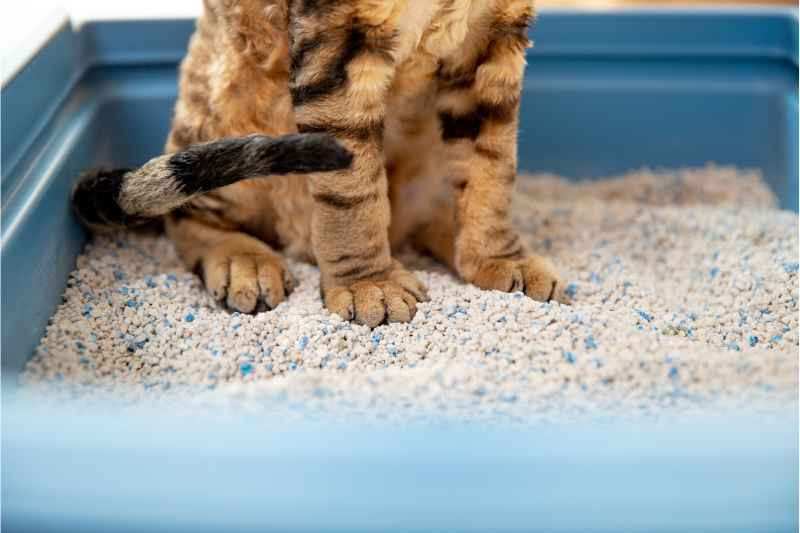Cats, whether they are neighborhood strays or adventurous pets, can sometimes become unwelcome visitors in your yard. While their presence might offer some benefits like rodent control, it often comes with downsides such as digging in gardens, using flower beds as litter boxes, and disturbing bird feeders. If you’re wondering how to effectively and humanely deter cats from your property, you’ve come to the right place.
This guide provides a comprehensive overview of 11 proven methods to keep cats out of your yard, ensuring your garden and outdoor spaces remain pristine and peaceful.
Understanding the Cat Dilemma: Indoor vs. Outdoor Felines
Historically, cats were primarily outdoor animals, playing a vital role in controlling rodent populations around farms and homes. The advent of kitty litter shifted the paradigm, turning cats into predominantly indoor companions. However, outdoor cats still exist in various forms:
- Owned Outdoor Cats: Some owners allow their domesticated cats to spend significant time outdoors.
- Stray Cats: These are socialized cats without a specific owner, often living within communities.
- Feral Cats: Unsocialized to humans, feral cat colonies may roam neighborhoods, using yards as territory, for waste disposal, or shelter.
Dealing with unwanted outdoor cat activity requires understanding different approaches to effectively deter them without causing harm. Let’s explore various strategies to reclaim your yard.
11 Ways to Deter Cats from Your Yard
Finding the right solution to keep cats away may require some experimentation. Cats react differently to various deterrents, so a combination of methods may prove most effective. Here are 11 strategies you can implement:
1. Utilize Scent Repellents: Essential Oils and Spices
 image of a black pepper in a wooden spoon
image of a black pepper in a wooden spoon
Photo Credit: Pixabay
Cats possess a highly sensitive sense of smell, which can be leveraged to deter them from entering your yard. Certain scents are naturally offensive to cats and can act as effective repellents. You can create homemade sprays using essential oils mixed with water or directly sprinkle spices in your garden beds. Scents known to repel cats include:
- Citrus scents (lemon, orange, lime)
- Lavender
- Rosemary
- Thyme
- Cinnamon
- Chili powder
- Cayenne pepper
- Black pepper
Commercial cat repellent sprays are also available at garden centers and online retailers. These products typically contain essential oils and plant-based ingredients that cats dislike. Remember to reapply homemade and commercial sprays, as well as spices, after rain or to new plant growth to maintain their effectiveness.
Important Note on Humane Use: While spices like black pepper and cayenne pepper are effective deterrents, they can be irritating to a cat’s sensitive nose and potentially cause burning sensations. Opt for milder scents and humane methods whenever possible.
2. Repel Cats with Citrus Peels and Coffee Grounds
Photo Credit: Ihar Leichonak / Canva Pro / License
If sprays aren’t your preferred method, citrus peels and coffee grounds offer alternative scent-based deterrents:
- Citrus Peels: Lemon, lime, and orange peels are natural cat repellents. Chop peels into small pieces and scatter them around areas where cats are unwanted, such as gardens or specific spots they frequent.
- Coffee Grounds: The strong aroma of coffee grounds is disliked by cats. Sprinkle a thin layer of coffee grounds around your yard or mix them into the soil. Reapply weekly to maintain the scent. Caution: Avoid piling up coffee grounds, as excessive amounts can be harmful to cats due to caffeine toxicity.
3. Plant Cat-Repelling Plants in Your Garden
 citronella mosquito repellent plant
citronella mosquito repellent plant
Photo Credit: EzumeImages / Canva Pro / License
For a more long-term and natural solution, consider incorporating plants that cats naturally avoid into your landscaping. These plants emit scents that are unpleasant to cats, effectively deterring them from entering your yard. Effective cat-repelling plants include:
- Citronella
- Lavender
- Rosemary
- Thyme
- Rue
- Pennyroyal
- Geraniums
- Eucalyptus
- Curry plant
Pro Tip: The Scaredy Cat Plant: Coleus canina, also known as the “scaredy cat plant,” emits an ammonia-like odor that cats find highly repulsive. While effective, be aware that humans can also detect this scent, especially when the plant is brushed or disturbed.
Additionally, increasing plant density in your garden can reduce exposed soil, making it less appealing for cats to dig and use as a litter box.
4. Utilize “Pointy” Mulch and Physical Barriers
Cats prefer soft surfaces for walking and digging. Making the ground less comfortable for their paws can effectively deter them. Consider using “pointy” or textured materials as mulch in your garden beds:
- Eggshells (crushed)
- Pine cones
- Holly cuttings
- Rose cuttings
- Twigs
- Coarse stone or wood mulch
Incorporate these materials into your mulch layer to create an uncomfortable surface for cats to walk on or dig in. You can also insert chopsticks or plastic forks into the soil, spaced about 8 inches apart, to further discourage digging.
For more robust physical barriers, consider:
- Chicken Wire or Bird Netting: Lay chicken wire or black bird netting just under the soil surface in garden beds to prevent cats from digging.
- Prickle Strips: Commercially available prickle strips made of rubber can be placed in areas where cats frequent. The soft prickles irritate their paws without causing harm.
- Latticework Fencing: Lay latticework fencing flat on the ground and plant through the holes. This creates a physical barrier while allowing plants to grow.
Important Note on Safety: Avoid using sharp or harmful objects that could injure cats’ paws. The goal is to create discomfort, not pain. Organic mulches are beneficial as they not only deter cats but also enrich the soil and support beneficial insects.
5. Apply Predator Urine Sprays
Photo Credit: Tambako The Jaguar / Flickr / CC BY-ND 2.0
In the natural world, predator scents signal danger to prey animals. This principle can be applied to deter cats from your yard. Predator urine, such as coyote or fox urine, can create the illusion of a threat, causing cats to avoid the area.
Commercial predator urine-based repellents are available in spray or granular form. Apply these products to problem areas like garden beds or perimeter of your yard.
Ethical Considerations: While effective, consider the source of predator urine. Some products may not be derived through humane methods. If animal welfare is a primary concern, explore other humane deterrent methods.
6. Deploy Ultrasonic Cat Repellents
Ultrasonic animal repellents emit high-frequency sound waves that are inaudible to humans but irritating to cats and other animals. These devices startle cats without causing them physical harm, effectively deterring them from the treated area.
Motion-activated ultrasonic repellents are particularly effective. They activate when they detect movement, emitting a startling sound burst when a cat enters your yard. These devices are available in plug-in or battery-operated models and can cover significant areas, up to 5,000 square feet in some cases.
Considerations: Ultrasonic repellents can also affect other animals, including dogs and wildlife. Consider the presence of other animals in your neighborhood before deploying these devices.
7. Install Motion-Activated Sprinklers
 cat near a sprinkler
cat near a sprinkler
Photo Credit: Nils Jacobi / Canva Pro / License
Motion-activated sprinklers are a highly effective and humane way to deter cats. A sudden burst of water startles cats, encouraging them to leave the area without causing harm. Unlike regular sprinkler systems, motion-activated sprinklers only activate when movement is detected, conserving water and providing targeted deterrence.
You can purchase motion-activated sprinklers from most home improvement or garden retailers or even create a DIY version. Adjust the sprinkler head settings to ensure coverage of your yard while avoiding unintended spray zones like driveways or walkways.
Potential Drawbacks: Motion-activated sprinklers can spray any creature that triggers the sensor, including humans. Placement and sensitivity adjustments are crucial to minimize accidental sprays.
8. Utilize Noisemakers: Aluminum Foil and More
Photo Credit: PublicDomainPictures
Cats are sensitive to unusual noises and textures. Utilizing noisemakers and unfamiliar materials can deter them from entering certain areas.
- Aluminum Foil: Cats dislike the feel and sound of aluminum foil under their paws. Place aluminum foil sheets in problem areas, on fences, or patio furniture. Be mindful that aluminum foil can reflect heat and potentially harm plants in direct sunlight.
- Other Noisemakers: Create auditory deterrents using:
- Aluminum pie pans hung on stakes
- Sheet metal pieces
- Old utensils hung to chime in the breeze
Sudden loud noises can also scare cats away. If you spot a cat in your yard, try shaking a can filled with marbles or pennies, blowing a whistle, or using an air horn. Remember to vary noise methods as cats may become accustomed to specific sounds over time.
Important Note for Cat Owners: Avoid using scare tactics like aluminum foil to deter your own indoor cat from countertops. This can negatively impact their mental well-being and lead to other behavioral issues. Instead, use positive reinforcement and redirect your cat to appropriate climbing and scratching areas.
9. Install a Tall Fence or Fence Toppers
For a more permanent and physical barrier, consider installing a tall fence around your yard. Cats are less adept at climbing smooth surfaces like vinyl fences compared to wood fences which offer better grip for their claws.
To enhance fence effectiveness, consider adding fence toppers:
- Prickle Strips: Attach prickle strips to the top of your fence to deter climbing.
- Roll Bars: Install roll bars along the top of the fence. These rotating bars prevent cats from gaining a foothold to climb over. You can purchase pre-made roll bars or create DIY versions.
10. Create a Designated Outdoor Litter Box
 brown cat sitting on a litter box
brown cat sitting on a litter box
Photo Credit: CasarsaGuru / Canva Pro / License
Sometimes, the best approach is to offer an alternative. Create a designated outdoor litter box in an inconspicuous area of your yard. This can redirect cats away from your garden beds. A simple sandbox or tilled patch of soil can serve as an outdoor litter area.
Regularly clean and maintain the outdoor litter box, as cats prefer clean litter areas. This can encourage them to use the designated spot instead of your garden.
11. Eliminate Cat Attractants in Your Yard
Photo Credit: Unsplash
Cats are drawn to yards that offer food, shelter, and safety. Removing these attractants can make your yard less appealing to them. Common cat attractants include:
- Pet Food: If you feed pets outdoors, promptly remove food bowls after meals.
- Food Waste: Secure trash can lids and clean up any food scraps from grills or outdoor eating areas.
- Shelter: Seal holes in foundations of houses or sheds that could serve as cat shelters. Before sealing any openings, ensure no cats are trapped inside.
- Cluttered Yard: Clear brush, leaves, and debris to eliminate hiding spots and reduce rodent populations that attract cats.
- Bird Feeders: Bird feeders can attract cats who prey on birds. Place feeders in open areas away from bushes or consider temporarily removing them to address a cat problem.
- Catnip: Avoid planting catnip in your yard as it is highly attractive to cats.
FAQ: Addressing Common Concerns About Cats in Yards
Why Is Keeping Cats Out of Your Yard Important?
While cats can be beneficial in controlling rodents, there are several reasons why you might want to deter them from your yard:
- Wildlife Habitat: If you’ve created a wildlife-friendly yard, cats can pose a threat to birds and other small animals.
- Allergies: Cat allergies can be triggered by outdoor cats entering your property.
- Pet Stress: Indoor cats or dogs may become stressed or agitated by the presence of outdoor cats.
- Garden Damage: Cats can damage gardens by digging, defecating in flower beds, and disturbing plants.
- Health Concerns: Cat feces can carry zoonotic diseases like salmonella, hookworms, tapeworms, and toxoplasmosis, posing health risks, especially to individuals with weakened immune systems and pregnant women.
Is Trapping Cats a Good Solution?
Trapping cats should be considered as a last resort. Animal shelters are often overcrowded, and trapped cats may face euthanasia. Humane trapping may be an option after exploring all other deterrent methods and checking local regulations, as trapping may be illegal in some areas.
If trapping is necessary, locate a shelter that can accept the cat beforehand. Use humane live traps and check them hourly to prevent prolonged stress or injury to trapped animals, including non-target animals like raccoons or skunks.
Important Note: If you trap a domestic cat, notify your neighbors and local shelters immediately.
Trap-Neuter-Return (TNR) programs are common in many areas to manage feral cat populations humanely. However, even TNR cats may still require deterrents to protect your yard.
What Should You Avoid Using to Repel Cats?
Never use mothballs as cat repellent. Mothballs contain naphthalene, which is toxic to cats. Ingestion or even inhalation can cause serious health issues. Using mothballs for pest control other than moths is often illegal.
Avoid planting plants that are toxic to cats in your yard, including:
- Lilies
- Tulips
- Azaleas
- Daffodils
- Amaryllis
These and other poisonous plants can be harmful if ingested by cats.
Seeking Professional Help
If you’ve tried various methods and are still struggling with cats in your yard, consider contacting a lawn care professional. They may offer additional advice and solutions tailored to your specific situation.
By implementing these humane and effective strategies, you can successfully keep cats out of your yard and enjoy your outdoor spaces without unwanted feline intrusions.
Additional Sources:
Cats Away
Pests Banned
The Commons
Catster
UW Botanic Gardens
Arizona Cooperative Extension
Main Image Credit: Unsplash

